Fluticasone Propionate 50 Micrograms Aqueous Nasal Spray
Flixonase contains benzalkonium chloride
Flixonase contains benzalkonium chloride
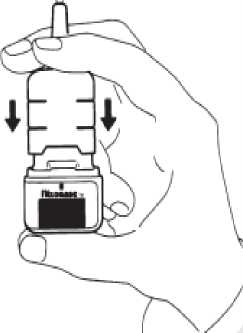
S1365 LEAFLET Flixonase 20141008
Package Leaflet: Information For The User FLIXONASE® AQUEOUS NASAL SPRAY (fluticasone propionate)
Your medicine is called Flixonase Aqueous Nasal Spray but it will be referred to as Flixonase throughout this leaflet.
Read all of this leaflet carefully before you start using this medicine because it contains important information for you.
• Keep this leaflet. You may need to read it again.
• If you have any further questions, ask your doctor or pharmacist.
• This medicine has been prescribed for you only. Do not pass it on to others. It may harm them, even if their signs of illness are the same as yours.
• If you get any side effects, talk to your doctor or pharmacist. This includes any possible side effects not listed in this leaflet. See section 4.
In this leaflet:
1 What Flixonase is and what it is used for
2 What you need to know before you use Flixonase
3 How to use Flixonase
4 Possible side effects
5 How to store Flixonase
6 Contents of the pack and other information
1 WHAT FLIXONASE IS AND WHAT IT IS USED FOR
Flixonase Aqueous Nasal Spray (called ‘Flixonase' in this leaflet)
contains a medicine called fluticasone propionate. This belongs to a
group of medicines called steroids (also called ‘cortico -steroids').
• Steroids work by reducing inflammation.
• They reduce swelling and irritation in your nose.
• This helps to relieve itching, sneezing and your blocked or runny nose.
Flixonase is used to prevent and treat:
• Inflammation in the lining of your nose (rhinitis) due to seasonal allergies, such as Hayfever.
• Inflammation in the lining of your nose (rhinitis) due to year round (perennial) allergies, such as animal allergies.
2 WHAT YOU NEED TO KNOW BEFORE YOU USE FLIXONASE
Do not use Flixonase if:
• You are allergic to fluticasone propionate or any of the other ingredients of this medicine (listed in section 6).
Warnings and precautions
Talk to your doctor or pharmacist before using Flixonase:
• If you have ever had an operation on your nose.
• If you have an infection in your nose
Other medicines and Flixonase
Tell your doctor if you are taking, have recently taken or might take any other medicines, including medicines obtained without a prescription. This includes herbal medicines.
Check with your doctor or pharmacist before using your medicine if:
• you have had steroids for a long time, either as an injection or by your mouth
• you are taking a type of antiviral medicine known as a protease inhibitor (e.g. ritonavir)
• you are taking certain medicines used to treat fungal infections (e.g. ketoconazole)
Taking Flixonase with food and drink
You can use Flixonase at any time of day, with or without food.
Benzalkonium chloride may cause problems with your breathing (bronchospasm).
3 HOW TO USE FLIXONASE
Always use this medicine exactly as your doctor has told you.
Check with your doctor or pharmacist if you are not sure.
Do not use in children under 4 years old.
• Only use in your nose, contact with eyes should be avoided.
• It takes a few days for this medicine to work. So keep using it, even though you may not feel better straight away.
• Use the spray every day.
How much to use - adults and children (aged 12 and over)
• The usual starting dose is 2 sprays into each nostril once a day, preferably in the morning.
• The most you would use over 24 hours is normally 8 sprays (4 sprays per nostril).
• As you become better, your doctor may ask you to use a lower dose - one spray into each nostril once a day.
• If your symptoms then get worse, your dose may be increased back to the starting dose.
How much to use - children aged 4 to 11 years
• The usual starting dose is one spray into each nostril once a day, preferably in the morning.
• The most you would use over 24 hours is normally 4 sprays (2 sprays per nostril).
If you use high doses of Flixonase
You may need extra steroids:
• in times of extreme stress
• during admission to hospital after a serious accident or injury
• before a surgical operation.
Your doctor may give you extra steroid medication such as tablets or an injection.
Preparing your spray
Each spray has a dust cap which protects the nozzle and keeps it clean. Remember to take this off before using the spray.
A new spray (or one that has not been used for a few days), may not work first time. You need to ‘prime' the spray by pumping the spray a few times until a fine mist is produced.
1 Hold the bottle as shown and make sure it is pointed away from you.
2 Put your forefinger and middle finger collar either side of the nozzle and put your thumb underneath the bottle.
3 Keep your thumb still, and press down with your fingers to pump the spray.
• If the spray does not work and you think it may be blocked, you will need to clean it. Please see the section below, Cleaning your spray.
• Never try to unblock or enlarge the tiny spray hole with a pin or other sharp object. This will damage the way the spray works.
Pregnancy and breast-feeding
If you are pregnant or breast-feeding, think you may be pregnant or are planning to have a baby, ask your doctor for advice before taking this medicine.
Driving and using machines
Flixonase is not likely to affect you being able to drive or use any tools or machines.
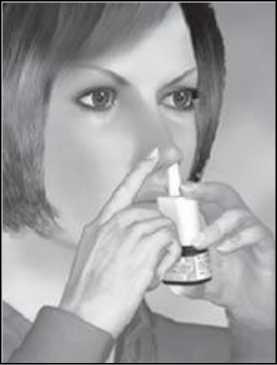
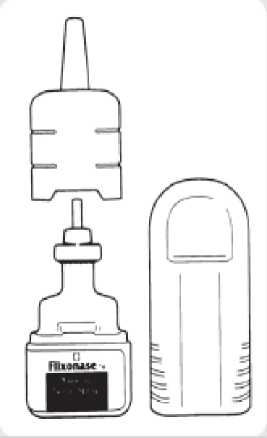
Using your spray
1 Shake the bottle and take off the dust cap.
2 Blow your nose gently.
3 Close one nostril with your finger as shown, and put the nozzle in the other nostril. Tilt your head forward slightly and keep the bottle upright. Hold the bottle as shown.
4 Start to breathe in slowly through your nose. While you are breathing in press down firmly on the collar with your fingers. A spray of fine mist will go into your nostril.
5 Breathe out through your mouth.
6 Repeat step 4 to use a second spray in the same nostril.
7 Remove the nozzle from this nostril and breathe out through your mouth.
8 Repeat steps 3 to 6 for your other nostril.
9 After using your spray, wipe the nozzle carefully with a clean tissue or handkerchief, and replace the dust cap.
Cleaning your spray
Clean your spray at least once
a week, or more often if it gets
blocked.
1 Take the dust cap off by gently squeezing the ribbed sides between your finger and thumb and lifting it off.
Do not twist it off.
2 Pull upwards on the white collar to remove the nozzle.
3 Soak the nozzle and dust cap in warm water for a few minutes.
4 Then rinse under a running tap.
5 Shake off the excess water and let them dry in a warm place.
6 Put the nozzle back on the spray.
7 ‘Prime’ the bottle as described in the section above, Preparing your spray
If you use more Flixonase than you should
Tell your doctor if you use more than you were told to.
It is important that you take your dose as stated on the pharmacist's label or as advised by your doctor. You should use only as much as your doctor recommends; using more or less may make your symptoms worse.
If you forget to use Flixonase
If you miss a dose, just use the next dose when it is due. Do not take a double dose to make up for the forgotten dose.
If you stop taking Flixonase
Do not stop treatment even if you feel better, unless your doctor tells you to stop. If you do stop, the symptoms may come back.
If you have any further questions on the use of this product, ask your doctor or pharmacist.
4 POSSIBLE SIDE EFFECTS
Like all medicines, this medicine can cause side effects, although not everybody gets them. The following side effects may happen with this medicine:
Allergic reactions: get a doctor’s help straight away
A small number of people get allergic reactions to Flixonase, which can develop into a more serious, even life-threatening problem if not treated. Symptoms include;
• becoming very wheezy, coughing or having difficulty with breathing
• suddenly feeling weak or light-headed (which may lead to collapse or loss of consciousness)
• swelling around the face, mouth or tongue
• skin rashes or redness
If this happens, tell your doctor straight away - you may need urgent medical treatment.
Allergic reactions to Flixonase are very rare (These affect less than 1 in 10,000 people).
Immediately after you use your spray
• You may sneeze a little, but this soon stops.
• Very occasionally you may find you get an unpleasant taste or smell.
Tell your doctor as soon as possible if you notice any of the following side effects:
Oth e r side effects include:
Very common (affects more than 1 in 10 people)
• Nose bleeds.
Common (may affect up to 1 in 10 people)
• Headache.
• Unpleasant taste.
• Unpleasant smell.
• A dry or painful nose or throat.
Very rare (may affect up to 1 in 10,000 people)
• Skin reaction - which can range from red, itchy rash and blotches to a more severe skin reaction such as dry, cracked and peeling skin.
• Problems with your eyes such as pain or blurred vision.
• Damage to your nose
Very rarely, the normal production of steroids in your body may be affected. This is more likely to happen if you use high doses for a long time. Your doctor will help stop this happening by making sure you use the lowest dose of steroid which controls your symptoms. In children this side effect can rarely cause them to grow more slowly than others. Children who receive this treatment for a long period of time will have their height checked regularly by their doctor.
Reporting of side effects
If you get any side effects, talk to your doctor, pharmacist or nurse. This includes any possible side effects not listed in this leaflet. You can also report side effects directly via the Yellow Card Scheme at: www.mhra.gov.uk/yellowcard.
By reporting side effects you can help provide more information on the safety of this medicine.
5 HOW TO STORE FLIXONASE
KEEP OUT OF THE SIGHT AND REACH OF CHILDREN.
Do not store above 30°C.
Do not put in a refrigerator. Avoid freezing.
Protect from light.
• Do not use Flixonase after the expiry date which is stated on the label and carton after ‘EXP'. The expiry date refers to the last day of that month.
• If you are told to stop taking this medicine return any unused spray to your pharmacist to be destroyed.
Medicines should not be disposed of via wastewater or household waste. Ask your pharmacist how to dispose of medicines no longer required. These measures will help to protect the environment.
If your medicine shows any other signs of deterioration, you should seek the advice of your pharmacist who will tell you what to do.
6 CONTENTS OF THE PACK AND OTHER INFORMATION
What Flixonase contains
• The active substance is fluticasone propionate
• The other ingredients are microcrystalline cellulose, sodium carboxymethylcellulose, dextrose anhydrous, polysorbate 80, purified water and the preservatives benzalkonium chloride and phenylethyl alcohol, diluted hydrochloric acid to adjust to pH to
6.3 - 6.5. These other ingredients are needed to make a stable suspension which will not go off.
What Flixonase Aqueous Nasal Spray looks like and contents of the pack
Flixonase Aqueous Nasal Spray is supplied in an amber glass bottle fitted with a metering, atomising pump. Pack size of 120 metered sprays.
Each spray contains 50 micrograms of fluticasone propionate. Product Licence holder
Procured from within the EU and repackaged by the Product Licence holder: S&M Medical Ltd, Chemilines House,
Alperton Lane, Wembley, HA0 1DX.
Manufacturer
This product is manufactured by GlaxoSmithKline Pharmaceuticals SA. 60-322 Poznan, Poland.
|POM | PL No: 19488/1365 Leaflet revision date: 08 October 2014
Flixonase is a registered trade mark of GlaxoSmithKline group of companies.
S1365 LEAFLET Flixonase 20141008
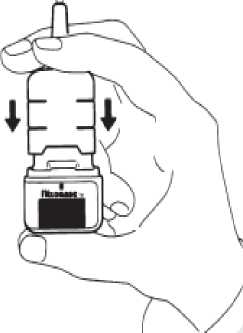
S1365 LEAFLET Fluticasone Propionate 20141008
Package Leaflet: Information For The User FLUTICASONE PROPIONATE 50 MICROGRAMS AQUEOUS NASAL SPRAY
Your medicine is called Fluticasone Propionate Aqueous Nasal Spray but it will be referred to as Fluticasone Propionate throughout this leaflet.
Read all of this leaflet carefully before you start using this medicine because it contains important information for you.
• Keep this leaflet. You may need to read it again.
• If you have any further questions, ask your doctor or pharmacist.
• This medicine has been prescribed for you only. Do not pass it on to others. It may harm them, even if their signs of illness are the same as yours.
• If you get any side effects, talk to your doctor or pharmacist. This includes any possible side effects not listed in this leaflet. See section 4.
In this leaflet:
1 What Fluticasone Propionate is and what it is used for
2 What you need to know before you use Fluticasone Propionate
3 How to use Fluticasone Propionate
4 Possible side effects
5 How to store Fluticasone Propionate
6 Contents of the pack and other information
1 WHAT FLUTICASONE PROPIONATE IS AND WHAT IT IS USED FOR
Fluticasone Propionate Aqueous Nasal Spray (called ‘ Fluticasone
Propionate' in this leaflet) contains a medicine called fluticasone
propionate. This belongs to a group of medicines called steroids
(also called ‘cortico-steroids').
• Steroids work by reducing inflammation.
• They reduce swelling and irritation in your nose.
• This helps to relieve itching, sneezing and your blocked or runny nose.
Fluticasone Propionate is used to prevent and treat:
• Inflammation in the lining of your nose (rhinitis) due to seasonal allergies, such as Hayfever.
• Inflammation in the lining of your nose (rhinitis) due to year round (perennial) allergies, such as animal allergies.
2 WHAT YOU NEED TO KNOW BEFORE YOU USE FLUTICASONE PROPIONATE
Do not use Fluticasone Propionate if:
• You are allergic to fluticasone propionate or any of the other ingredients of this medicine (listed in section 6).
Warnings and precautions
Talk to your doctor or pharmacist before using Fluticasone
Propionate:
• If you have ever had an operation on your nose.
• If you have an infection in your nose
Other medicines and Fluticasone Propionate
Tell your doctor if you are taking, have recently taken or might take
any other medicines, including medicines obtained without a
prescription. This includes herbal medicines.
Check with your doctor or pharmacist before using your medicine if:
• you have had steroids for a long time, either as an injection or by your mouth
• you are taking a type of antiviral medicine known as a protease inhibitor (e.g. ritonavir)
• you are taking certain medicines used to treat fungal infections (e.g. ketoconazole)
Benzalkonium chloride may cause problems with your breathing (bronchospasm).
3 HOW TO USE FLUTICASONE PROPIONATE
Always use this medicine exactly as your doctor has told you.
Check with your doctor or pharmacist if you are not sure.
Do not use in children under 4 years old.
• Only use in your nose, contact with eyes should be avoided.
• It takes a few days for this medicine to work. So keep using it, even though you may not feel better straight away.
• Use the spray every day.
How much to use - adults and children (aged 12 and over)
• The usual starting dose is 2 sprays into each nostril once a day, preferably in the morning.
• The most you would use over 24 hours is normally 8 sprays (4 sprays per nostril).
• As you become better, your doctor may ask you to use a lower dose - one spray into each nostril once a day.
• If your symptoms then get worse, your dose may be increased back to the starting dose.
How much to use - children aged 4 to 11 years
• The usual starting dose is one spray into each nostril once a day, preferably in the morning.
• The most you would use over 24 hours is normally 4 sprays (2 sprays per nostril).
If you use high doses of Fluticasone Propionate
You may need extra steroids:
• in times of extreme stress
• during admission to hospital after a serious accident or injury
• before a surgical operation.
Your doctor may give you extra steroid medication such as tablets or an injection.
Preparing your spray
Each spray has a dust cap which protects the nozzle and keeps it clean. Remember to take this off before using the spray.
A new spray (or one that has not been used for a few days), may not work first time. You need to ‘prime' the spray by pumping the spray a few times until a fine mist is produced.
1 Hold the bottle as shown and make sure it is pointed away from you.
2 Put your forefinger and middle finger collar either side of the nozzle and put your thumb underneath the bottle.
3 Keep your thumb still, and press down with your fingers to pump the spray.
• If the spray does not work and you think it may be blocked, you will need to clean it. Please see the section below, Cleaning your spray.
• Never try to unblock or enlarge the tiny spray hole with a pin or other sharp object. This will damage the way the spray works.
Taking Fluticasone Propionate with food and drink
You can use Fluticasone Propionate at any time of day, with or without food.
Pregnancy and breast-feeding
If you are pregnant or breast-feeding, think you may be pregnant or are planning to have a baby, ask your doctor for advice before taking this medicine.
Driving and using machines
Fluticasone Propionate is not likely to affect you being able to drive or use any tools or machines.
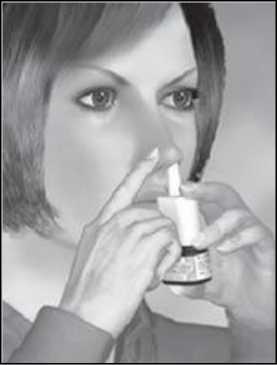
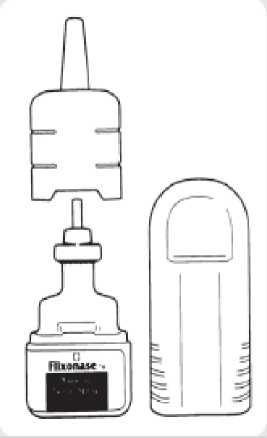
Using your spray
1 Shake the bottle and take off the dust cap.
2 Blow your nose gently.
3 Close one nostril with your finger as shown, and put the nozzle in the other nostril. Tilt your head forward slightly and keep the bottle upright. Hold the bottle as shown.
4 Start to breathe in slowly through your nose. While you are breathing in press down firmly on the collar with your fingers. A spray of fine mist will go into your nostril.
5 Breathe out through your mouth.
6 Repeat step 4 to use a second spray in the same nostril.
7 Remove the nozzle from this nostril and breathe out through your mouth.
8 Repeat steps 3 to 6 for your other nostril.
9 After using your spray, wipe the nozzle carefully with a clean tissue or handkerchief, and replace the dust cap.
Cleaning your spray
Clean your spray at least once
a week, or more often if it gets
blocked.
1 Take the dust cap off by gently squeezing the ribbed sides between your finger and thumb and lifting it off.
Do not twist it off.
2 Pull upwards on the white collar to remove the nozzle.
3 Soak the nozzle and dust cap in warm water for a few minutes.
4 Then rinse under a running tap.
5 Shake off the excess water and let them dry in a warm place.
6 Put the nozzle back on the spray.
7 ‘Prime’ the bottle as described in the section above, Preparing your spray
If you use more Fluticasone Propionate than you should
Tell your doctor if you use more than you were told to.
It is important that you take your dose as stated on the pharmacist's label or as advised by your doctor. You should use only as much as your doctor recommends; using more or less may make your symptoms worse.
If you forget to use Fluticasone Propionate
If you miss a dose, just use the next dose when it is due. Do not take a double dose to make up for the forgotten dose.
If you stop taking Fluticasone Propionate
Do not stop treatment even if you feel better, unless your doctor
tells you to stop. If you do stop, the symptoms may come back.
If you have any further questions on the use of this product, ask your doctor or pharmacist.
4 POSSIBLE SIDE EFFECTS
Like all medicines, this medicine can cause side effects, although not everybody gets them. The following side effects may happen with this medicine:
Allergic reactions: get a doctor’s help straight away
A small number of people get allergic reactions to Fluticasone Propionate, which can develop into a more serious, even life-threatening problem if not treated. Symptoms include;
• becoming very wheezy, coughing or having difficulty with breathing
• suddenly feeling weak or light-headed (which may lead to collapse or loss of consciousness)
• swelling around the face, mouth or tongue
• skin rashes or redness
If this happens, tell your doctor straight away - you may need urgent medical treatment.
Allergic reactions to Fluticasone Propionate are very rare (These affect less than 1 in 10,000 people).
Immediately after you use your spray
• You may sneeze a little, but this soon stops.
• Very occasionally you may find you get an unpleasant taste or smell.
Tell your doctor as soon as possible if you notice any of the following side effects:
Oth e r side effects include:
Very common (affects more than 1 in 10 people)
• Nose bleeds.
Common (may affect up to 1 in 10 people)
• Headache.
• Unpleasant taste.
• Unpleasant smell.
• A dry or painful nose or throat.
Very rare (may affect up to 1 in 10,000 people)
• Skin reaction - which can range from red, itchy rash and blotches to a more severe skin reaction such as dry, cracked and peeling skin.
• Problems with your eyes such as pain or blurred vision.
• Damage to your nose
Very rarely, the normal production of steroids in your body may be affected. This is more likely to happen if you use high doses for a long time. Your doctor will help stop this happening by making sure you use the lowest dose of steroid which controls your symptoms. In children this side effect can rarely cause them to grow more slowly than others. Children who receive this treatment for a long period of time will have their height checked regularly by their doctor.
Reporting of side effects
If you get any side effects, talk to your doctor, pharmacist or nurse. This includes any possible side effects not listed in this leaflet. You can also report side effects directly via the Yellow Card Scheme at: www.mhra.gov.uk/yellowcard.
By reporting side effects you can help provide more information on the safety of this medicine.
5 HOW TO STORE FLUTICASONE PROPIONATE
KEEP OUT OF THE SIGHT AND REACH OF CHILDREN.
Do not store above 30°C.
Do not put in a refrigerator.
Avoid freezing. Protect from light.
• Do not use Fluticasone Propionate after the expiry date which is stated on the label and carton after ‘EXP'. The expiry date refers to the last day of that month.
• If you are told to stop taking this medicine return any unused spray to your pharmacist to be destroyed.
Medicines should not be disposed of via wastewater or household waste. Ask your pharmacist how to dispose of medicines no longer required. These measures will help to protect the environment.
If your medicine shows any other signs of deterioration, you should seek the advice of your pharmacist who will tell you what to do.
6 FURTHER INFORMATION
What Fluticasone Propionate contains
• The active substance is fluticasone propionate
• The other ingredients are microcrystalline cellulose, sodium carboxymethylcellulose, dextrose anhydrous, polysorbate 80, purified water and the preservatives benzalkonium chloride and phenylethyl alcohol, diluted hydrochloric acid to adjust to pH to
6.3 - 6.5. These other ingredients are needed to make a stable suspension which will not go off.
What Fluticasone Propionate Aqueous Nasal Spray looks like and contents of the pack
Fluticasone Propionate Aqueous Nasal Spray is supplied in an amber glass bottle fitted with a metering, atomising pump. Pack size of 120 metered sprays.
Each spray contains 50 micrograms of fluticasone propionate. Product Licence holder
Procured from within the EU and repackaged by the Product Licence holder: S&M Medical Ltd, Chemilines House,
Alperton Lane, Wembley, HA0 1DX.
Manufacturer
This product is manufactured by GlaxoSmithKline Pharmaceuticals SA. 60-322 Poznan, Poland.
|POM | PL No: 19488/1365 Leaflet revision date: 08 October 2014
S1365 LEAFLET Fluticasone Propionate 20141008

S1365 LEAFLET Flixonase 20141008 new
Package Leaflet: Information For The User FLIXONASE® AQUEOUS NASAL SPRAY (fluticasone propionate)
Your medicine is called Flixonase Aqueous Nasal Spray but it will be referred to as Flixonase throughout this leaflet.
Read all of this leaflet carefully before you start using this medicine because it contains important information for you.
• Keep this leaflet. You may need to read it again.
• If you have any further questions, ask your doctor or pharmacist.
• This medicine has been prescribed for you only. Do not pass it on to others. It may harm them, even if their signs of illness are the same as yours.
• If you get any side effects, talk to your doctor or pharmacist. This includes any possible side effects not listed in this leaflet. See section 4.
In this leaflet:
1 What Flixonase is and what it is used for
2 What you need to know before you use Flixonase
3 How to use Flixonase
4 Possible side effects
5 How to store Flixonase
6 Contents of the pack and other information
1 WHAT FLIXONASE IS AND WHAT IT IS USED FOR
Flixonase Aqueous Nasal Spray (called ‘Flixonase' in this leaflet)
contains a medicine called fluticasone propionate. This belongs to a
group of medicines called steroids (also called ‘cortico -steroids').
• Steroids work by reducing inflammation.
• They reduce swelling and irritation in your nose.
• This helps to relieve itching, sneezing and your blocked or runny nose.
Flixonase is used to prevent and treat:
• Inflammation in the lining of your nose (rhinitis) due to seasonal allergies, such as Hayfever.
• Inflammation in the lining of your nose (rhinitis) due to year round (perennial) allergies, such as animal allergies.
2 WHAT YOU NEED TO KNOW BEFORE YOU USE FLIXONASE
Do not use Flixonase if:
• You are allergic to fluticasone propionate or any of the other ingredients of this medicine (listed in section 6).
Warnings and precautions
Talk to your doctor or pharmacist before using Flixonase:
• If you have ever had an operation on your nose.
• If you have an infection in your nose
Other medicines and Flixonase
Tell your doctor if you are taking, have recently taken or might take any other medicines, including medicines obtained without a prescription. This includes herbal medicines.
Check with your doctor or pharmacist before using your medicine if:
• you have had steroids for a long time, either as an injection or by your mouth
• you are taking a type of antiviral medicine known as a protease inhibitor (e.g. ritonavir)
• you are taking certain medicines used to treat fungal infections (e.g. ketoconazole)
Taking Flixonase with food and drink
You can use Flixonase at any time of day, with or without food.
Driving and using machines
Flixonase is not likely to affect you being able to drive or use any tools or machines.
Flixonase contains benzalkonium chloride
Benzalkonium chloride may cause problems with your breathing (bronchospasm).
3 HOW TO USE FLIXONASE
Always use this medicine exactly as your doctor has told you.
Check with your doctor or pharmacist if you are not sure.
Do not use in children under 4 years old.
• Only use in your nose, contact with eyes should be avoided.
• It takes a few days for this medicine to work. So keep using it, even though you may not feel better straight away.
• Use the spray every day.
How much to use - adults and children (aged 12 and over)
• The usual starting dose is 2 sprays into each nostril once a day, preferably in the morning.
• The most you would use over 24 hours is normally 8 sprays (4 sprays per nostril).
• As you become better, your doctor may ask you to use a lower dose - one spray into each nostril once a day.
• If your symptoms then get worse, your dose may be increased back to the starting dose.
How much to use - children aged 4 to 11 years
• The usual starting dose is one spray into each nostril once a day, preferably in the morning.
• The most you would use over 24 hours is normally 4 sprays (2 sprays per nostril).
If you use high doses of Flixonase
You may need extra steroids:
• in times of extreme stress
• during admission to hospital after a serious accident or injury
• before a surgical operation.
Your doctor may give you extra steroid medication such as tablets or an injection.
Preparing your spray
Each spray has a dust cap which protects the nozzle and keeps it clean. Remember to take this off before using the spray.
A new spray (or one that has not been used for a few days), may not work first time. You need to ‘prime' the spray by pumping the spray a few times until a fine mist is produced.
1 Hold the bottle as shown and make sure it is pointed away from you.
2 Put your forefinger and middle finger collar either side of the nozzle and put your thumb underneath the bottle.
3 Keep your thumb still, and press down with your fingers to pump the spray.
• If the spray does not work and you think it may be blocked, you will need to clean it. Please see the section below, Cleaning your spray.
• Never try to unblock or enlarge the tiny spray hole with a pin or other sharp object. This will damage the way the spray works.
Pregnancy and breast-feeding
If you are pregnant or breast-feeding, think you may be pregnant or are planning to have a baby, ask your doctor for advice before taking this medicine.

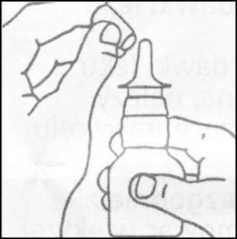
Using your spray
1 Shake the bottle and take off the dust cap.
2 Blow your nose gently.
3 Close one nostril with your finger as shown, and put the nozzle in the other nostril. Tilt your head forward slightly and keep the bottle upright. Hold the bottle as shown.
4 Start to breathe in slowly through your nose. While
you are breathing in press down firmly on the collar with your fingers. A spray of fine mist will go into your nostril.
5 Breathe out through your mouth.
6 Repeat step 4 to use a second spray in the same nostril.
7 Remove the nozzle from this nostril and breathe out through your mouth.
8 Repeat steps 3 to 6 for your other nostril.
9 After using your spray, wipe the nozzle carefully with a clean tissue or handkerchief, and replace the dust cap.
Cleaning your spray
Clean your spray at least once
a week, or more often if it gets
blocked.
1 Take the dust cap off.
Do not twist it off.
2 Pull upwards on the white collar to remove the nozzle.
3 Soak the nozzle and dust cap in warm water for a few minutes.
4 Then rinse under a running tap.
5 Shake off the excess water and let them dry in a warm place.
6 Put the nozzle back on the spray.
7 ‘Prime' the bottle as described in the section above, Preparing your spray
If you use more Flixonase than you should
Tell your doctor if you use more than you were told to.
It is important that you take your dose as stated on the pharmacist's label or as advised by your doctor. You should use only as much as your doctor recommends; using more or less may make your symptoms worse.
If you forget to use Flixonase
If you miss a dose, just use the next dose when it is due. Do not take a double dose to make up for the forgotten dose.
If you stop taking Flixonase
Do not stop treatment even if you feel better, unless your doctor tells you to stop. If you do stop, the symptoms may come back.
If you have any further questions on the use of this product, ask your doctor or pharmacist.
4 POSSIBLE SIDE EFFECTS
Like all medicines, this medicine can cause side effects, although not everybody gets them. The following side effects may happen with this medicine:
Allergic reactions: get a doctor’s help straight away
A small number of people get allergic reactions to Flixonase, which can develop into a more serious, even life-threatening problem if not treated. Symptoms include;
• becoming very wheezy, coughing or having difficulty with breathing
• suddenly feeling weak or light-headed (which may lead to collapse or loss of consciousness)
• swelling around the face, mouth or tongue
• skin rashes or redness
If this happens, tell your doctor straight away - you may need urgent medical treatment.
Allergic reactions to Flixonase are very rare (These affect less than 1 in 10,000 people).
Immediately after you use your spray
• You may sneeze a little, but this soon stops.
• Very occasionally you may find you get an unpleasant taste or smell.
Tell your doctor as soon as possible if you notice any of the following side effects:
Other side effects include:
Very common (affects more than 1 in 10 people)
• Nose bl eed s .
Common (may affect up to 1 in 10 people)
• Headache.
• Unpleasant taste.
• Unpleasant smell.
• A dry or painful nose or throat.
Very rare (may affect up to 1 in 10,000 people)
• Skin reaction - which can range from red, itchy rash and blotches to a more severe skin reaction such as dry, cracked and peeling skin.
• Problems with your eyes such as pain or blurred vision.
• Damage to your nose
Very rarely, the normal production of steroids in your body may be affected. This is more likely to happen if you use high doses for a long time. Your doctor will help stop this happening by making sure you use the lowest dose of steroid which controls your symptoms. In children this side effect can rarely cause them to grow more slowly than others. Children who receive this treatment for a long period of time will have their height checked regularly by their doctor.
Reporting of side effects
If you get any side effects, talk to your doctor, pharmacist or nurse. This includes any possible side effects not listed in this leaflet. You can also report side effects directly via the Yellow Card Scheme at: www.mhra.gov.uk/yellowcard.
By reporting side effects you can help provide more information on the safety of this medicine.
5 HOW TO STORE FLIXONASE
• KEEP OUT OF THE SIGHT AND REACH OF CHILDREN.
• Do not store above 30°C.
• Do not put in a refrigerator.
• Avoid freezing.
• Protect from light.
• Do not use Flixonase after the expiry date which is stated on the label and carton after ‘EXP'. The expiry date refers to the last day of that month.
• If you are told to stop taking this medicine return any unused spray to your pharmacist to be destroyed.
Medicines should not be disposed of via wastewater or household
waste. Ask your pharmacist how to dispose of medicines no longer
required. These measures will help to protect the environment.
If your medicine shows any other signs of deterioration, you should
seek the advice of your pharmacist who will tell you what to do.
6 CONTENTS OF THE PACK AND OTHER INFORMATION
What Flixonase contains
• The active substance is fluticasone propionate
• The other ingredients are microcrystalline cellulose, sodium carboxymethylcellulose, dextrose anhydrous, polysorbate 80, purified water and the preservatives benzalkonium chloride and phenylethyl alcohol, diluted hydrochloric acid to adjust to pH to
6.3 - 6.5. These other ingredients are needed to make a stable suspension which will not go off.
What Flixonase Aqueous Nasal Spray looks like and contents of the pack
Flixonase Aqueous Nasal Spray is supplied in a white plastic bottle with pump and transparent dust cap. Pack size of 120 metered sprays.
Each spray contains 50 micrograms of fluticasone propionate. Product Licence holder
Procured from within the EU and repackaged by the Product Licence holder: S&M Medical Ltd, Chemilines House,
Alperton Lane, Wembley, HA0 1DX.
Manufacturer
This product is manufactured by Glaxo Wellcome S.A., 3 Avenida de Extremadura, 09400 Aranda de Duero, Burgos, Spain.
|POM | PL No: 19488/1365 Leaflet revision date: 08 October 2014
Flixonase is a registered trade mark of GlaxoSmithKline group of companies.
S1365 LEAFLET Flixonase 20141008
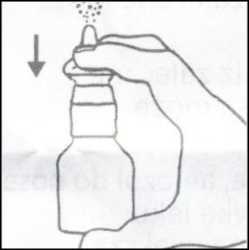
S1365 LEAFLET Fluticasone Propionate 20141008 new
Package Leaflet: Information For The User FLUTICASONE PROPIONATE 50 MICROGRAMS AQUEOUS NASAL SPRAY
Your medicine is called Fluticasone Propionate Aqueous Nasal Spray but it will be referred to as Fluticasone Propionate throughout this leaflet.
Read all of this leaflet carefully before you start using this medicine because it contains important information for you.
• Keep this leaflet. You may need to read it again.
• If you have any further questions, ask your doctor or pharmacist.
• This medicine has been prescribed for you only. Do not pass it on to others. It may harm them, even if their signs of illness are the same as yours.
• If you get any side effects, talk to your doctor or pharmacist. This includes any possible side effects not listed in this leaflet. See section 4.
In this leaflet:
1 What Fluticasone Propionate is and what it is used for
2 What you need to know before you use Fluticasone Propionate
3 How to use Fluticasone Propionate
4 Possible side effects
5 How to store Fluticasone Propionate
6 Contents of the pack and other information
1 WHAT FLUTICASONE PROPIONATE IS AND WHAT IT IS USED FOR
Fluticasone Propionate Aqueous Nasal Spray (called ‘ Fluticasone
Propionate' in this leaflet) contains a medicine called fluticasone
propionate. This belongs to a group of medicines called steroids
(also called ‘cortico-steroids').
• Steroids work by reducing inflammation.
• They reduce swelling and irritation in your nose.
• This helps to relieve itching, sneezing and your blocked or runny nose.
Fluticasone Propionate is used to prevent and treat:
• Inflammation in the lining of your nose (rhinitis) due to seasonal allergies, such as Hayfever.
• Inflammation in the lining of your nose (rhinitis) due to year round (perennial) allergies, such as animal allergies.
2 WHAT YOU NEED TO KNOW BEFORE YOU USE FLUTICASONE PROPIONATE
Do not use Fluticasone Propionate if:
• You are allergic to fluticasone propionate or any of the other ingredients of this medicine (listed in section 6).
Warnings and precautions
Talk to your doctor or pharmacist before using Fluticasone Propionate:
• If you have ever had an operation on your nose.
• If you have an infection in your nose
Other medicines and Fluticasone Propionate
Tell your doctor if you are taking, have recently taken or might take
any other medicines, including medicines obtained without a
prescription. This includes herbal medicines.
Check with your doctor or pharmacist before using your medicine if:
• you have had steroids for a long time, either as an injection or by your mouth
• you are taking a type of antiviral medicine known as a protease inhibitor (e.g. ritonavir)
• you are taking certain medicines used to treat fungal infections (e.g. ketoconazole)
Taking Fluticasone Propionate with food and drink
You can use Fluticasone Propionate at any time of day, with or without food.
P reg na ncy and breast-feeding
If you are pregnant or breast-feeding, think you may be pregnant or are planning to have a baby, ask your doctor for advice before taking this medicine.
Driving and using machines
Fluticasone Propionate is not likely to affect you being able to drive or use any tools or machines.
Fluticasone Propionate contains benzalkonium chloride
Benzalkonium chloride may cause problems with your breathing (bronchospasm).
3 HOW TO USE FLUTICASONE PROPIONATE
Always use this medicine exactly as your doctor has told you.
Check with your doctor or pharmacist if you are not sure.
Do not use in children under 4 years old.
• Only use in your nose, contact with eyes should be avoided.
• It takes a few days for this medicine to work. So keep using it, even though you may not feel better straight away.
• Use the spray every day.
How much to use - adults and children (aged 12 and over)
• The usual starting dose is 2 sprays into each nostril once a day, preferably in the morning.
• The most you would use over 24 hours is normally 8 sprays (4 sprays per nostril).
• As you become better, your doctor may ask you to use a lower dose - one spray into each nostril once a day.
• If your symptoms then get worse, your dose may be increased back to the starting dose.
How much to use - children aged 4 to 11 years
• The usual starting dose is one spray into each nostril once a day, preferably in the morning.
• The most you would use over 24 hours is normally 4 sprays (2 sprays per nostril).
If you use high doses of Fluticasone Propionate
You may need extra steroids:
• in times of extreme stress
• during admission to hospital after a serious accident or injury
• before a surgical operation.
Your doctor may give you extra steroid medication such as tablets
or an injection.
Preparing your spray
Each spray has a dust cap which protects the nozzle and keeps it
clean. Remember to take this off before using the spray.
A new spray (or one that has not been used for a few days), may
not work first time. You need to ‘prime' the spray by pumping the
spray a few times until a fine mist is produced.
1 Hold the bottle as shown and make sure it is pointed away from you.
2 Put your forefinger and middle finger collar either side of the nozzle and put your thumb underneath the bottle.
3 Keep your thumb still, and press down with your fingers to pump the spray.
• If the spray does not work and you think it may be blocked, you will need to clean it. Please see the section below, Cleaning your spray.
• Never try to unblock or enlarge the tiny spray hole with a pin or other sharp object. This will damage the way the spray works.
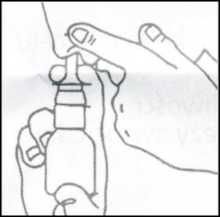
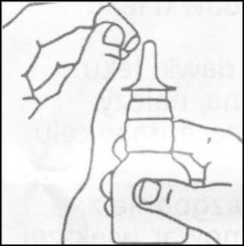
Using your spray
1 Shake the bottle and take off the dust cap.
2 Blow your nose gently.
3 Close one nostril with your finger as shown, and put the nozzle in the other nostril. Tilt your head forward slightly and keep the bottle upright. Hold the bottle as shown.
4 Start to breathe in slowly through your nose. While you are breathing in press down firmly on the collar with your fingers. A spray of fine mist will go into your nostril.
5 Breathe out through your mouth.
6 Repeat step 4 to use a second spray in the same nostril.
7 Remove the nozzle from this nostril and breathe out through your mouth.
8 Repeat steps 3 to 6 for your other nostril.
9 After using your spray, wipe the nozzle carefully with a clean tissue or handkerchief, and replace the dust cap.
Cleaning your spray
Clean your spray at least once
a week, or more often if it gets
blocked.
1 Take the dust cap off.
Do not twist it off.
2 Pull upwards on the white collar to remove the nozzle.
3 Soak the nozzle and dust cap in warm water for a few minutes.
4 Then rinse under a running tap.
5 Shake off the excess water and let them dry in a warm place.
6 Put the nozzle back on the spray.
7 ‘Prime' the bottle as described in the section above, Preparing your spray
If you use more Fluticasone Propionate than you should
Tell your doctor if you use more than you were told to.
It is important that you take your dose as stated on the pharmacist's label or as advised by your doctor. You should use only as much as your doctor recommends; using more or less may make your symptoms worse.
If you forget to use Fluticasone Propionate
If you miss a dose, just use the next dose when it is due. Do not take a double dose to make up for the forgotten dose.
If you stop taking Fluticasone Propionate
Do not stop treatment even if you feel better, unless your doctor
tells you to stop. If you do stop, the symptoms may come back.
If you have any further questions on the use of this product, ask your doctor or pharmacist.
4 POSSIBLE SIDE EFFECTS
Like all medicines, this medicine can cause side effects, although not everybody gets them. The following side effects may happen with this medicine:
Allergic reactions: get a doctor’s help straight away
A small number of people get allergic reactions to Fluticasone Propionate, which can develop into a more serious, even life-threatening problem if not treated. Symptoms include;
• becoming very wheezy, coughing or having difficulty with breathing
• suddenly feeling weak or light-headed (which may lead to collapse or loss of consciousness)
• swelling around the face, mouth or tongue
• skin rashes or redness
If this happens, tell your doctor straight away - you may need urgent medical treatment.
Allergic reactions to Fluticasone Propionate are very rare (These affect less than 1 in 10,000 people).
Immediately after you use your spray
• You may sneeze a little, but this soon stops.
• Very occasionally you may find you get an unpleasant taste or smell.
Tell your doctor as soon as possible if you notice any of the following side effects:
Other side effects include:
Very common (affects more than 1 in 10 people)
• N ose bl eed s .
Common (may affect up to 1 in 10 people)
• Headache.
• Unpleasant taste.
• Unpleasant smell.
• A dry or painful nose or throat.
Very rare (may affect up to 1 in 10,000 people)
• S ki n re action - which can range from red, itchy rash and blotches to a more severe skin reaction such as dry, cracked and peeling skin.
• Problems with your eyes such as pain or blurred vision.
• Damage to your nose
Very rarely, the normal production of steroids in your body may be affected. This is more likely to happen if you use high doses for a long time. Your doctor will help stop this happening by making sure you use the lowest dose of steroid which controls your symptoms. In children this side effect can rarely cause them to grow more slowly than others. Children who receive this treatment for a long period of time will have their height checked regularly by their doctor.
Reporting of side effects
If you get any side effects, talk to your doctor, pharmacist or nurse. This includes any possible side effects not listed in this leaflet. You can also report side effects directly via the Yellow Card Scheme at: www.mhra.gov.uk/yellowcard By reporting side effects you can help provide more information on the safety of this medicine.
5 HOW TO STORE FLUTICASONE PROPIONATE
• KEEP OUT OF THE SIGHT AND REACH OF CHILDREN.
• Do not store above 30°C.
• Do not put in a refrigerator.
• Avoid freezing.
• Protect from light.
• Do not use Fluticasone Propionate after the expiry date which is stated on the label and carton after ‘EXP'. The expiry date refers to the last day of that month.
• If you are told to stop taking this medicine return any unused spray to your pharmacist to be destroyed.
Medicines should not be disposed of via wastewater or household
waste. Ask your pharmacist how to dispose of medicines no longer
required. These measures will help to protect the environment.
If your medicine shows any other signs of deterioration, you should
seek the advice of your pharmacist who will tell you what to do.
6 CONTENTS OF THE PACK AND OTHER INFORMATION
What Fluticasone Propionate contains
• The active substance is fluticasone propionate
• The other ingredients are microcrystalline cellulose, sodium carboxymethylcellulose, dextrose anhydrous, polysorbate 80, purified water and the preservatives benzalkonium chloride and phenylethyl alcohol, diluted hydrochloric acid to adjust to pH to
6.3 - 6.5. These other ingredients are needed to make a stable suspension which will not go off.
What Fluticasone Propionate Aqueous Nasal Spray looks like and contents of the pack
Fluticasone Propionate Aqueous Nasal Spray is supplied in a white plastic bottle with pump and transparent dust cap. Pack size of 120 metered sprays.
Each spray contains 50 micrograms of fluticasone propionate. Product Licence holder
Procured from within the EU and repackaged by the Product Licence holder: S&M Medical Ltd, Chemilines House,
Alperton Lane, Wembley, HA0 1DX.
Manufacturer
This product is manufactured by Glaxo Wellcome S.A., 3 Avenida de Extremadura, 09400 Aranda de Duero, Burgos, Spain.
| POM | PL No: 19488/1365 Leaflet revision date: 08 October 2014
S1365 LEAFLET Fluticasone Propionate 20141008 new